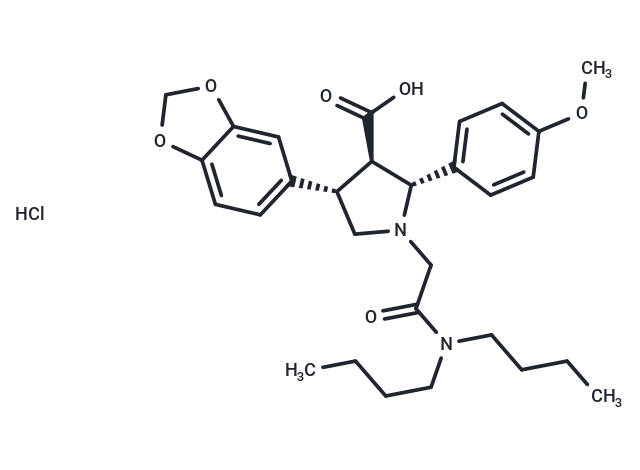Shopping Cart
- Remove All
 Your shopping cart is currently empty
Your shopping cart is currently empty

Atrasentan hydrochloride (ABT-627 hydrochloride) is an endothelin receptor antagonist with an IC50 of 55.1 μM for ETA.

| Pack Size | Price | Availability | Quantity |
|---|---|---|---|
| 2 mg | $35 | In Stock | |
| 5 mg | $58 | In Stock | |
| 10 mg | $83 | In Stock | |
| 25 mg | $167 | In Stock | |
| 50 mg | Inquiry | In Stock | |
| 1 mL x 10 mM (in DMSO) | $70 | In Stock |
| Description | Atrasentan hydrochloride (ABT-627 hydrochloride) is an endothelin receptor antagonist with an IC50 of 55.1 μM for ETA. |
| Targets&IC50 | ETA:55.1 μM |
| In vitro | Atrasentan (0-50 μM) significantly inhibits LNCaP and C4-2b prostate cancer cell growth. ABT-627 in combination with Taxotere elicits a significantly greater loss of viable prostate cancer cells relative to either agent alone and shows a greater degree of down-regulation of the NF-κB DNA binding activity [2]. Atrasentan profoundly induces several CYPs and drug transporters. It is a moderate P-gp inhibitor (IC50: 15.1 μM in P388/dx cells) and a weak BCRP inhibitor (IC50: 59.8 μM in MDCKII-BCRP cells) [3]. |
| In vivo | Atrasentan (3 mg/kg, p.o.) inhibits the pressor response induced by big endothelin-1 (1 nmol/kg) in pithed rats [1]. Aatrasentan (10 mg/kg, i.p.) inhibited the C4-2b tumor growth within the bone environment to some extent in the SCID-hu model [2]. |
| Kinase Assay | Cells are incubated and treated with Atrasentan. They are then washed twice with PBS and lysed in ice-cold lysis buffer [20 mM Tris (pH 7.4), 150 mM NaCl, 1% Triton X-100, 1 mM EDTA, 1 mM EGTA, 2.5 mM sodium PPi, 1 mM β-glycerophosphate, 1 mM sodium orthovanadate, 1 μg/mL leupeptin, and 1 mM PMSF]. The extracts are centrifuged to remove cellular debris, and the protein content of the supernatants is determined using the bicinchoninic acid (BCA) protein assay reagent. Proteins (150 μg) are incubated with gentle rocking at 4°C overnight with immobilized Akt antibody cross-linked to agarose hydrazide beads. After the Akt is selectively immunoprecipitated from the cell lysates, the immunoprecipitated products are washed twice with lysis buffer and twice with kinase assay buffer [25 mM Tris (pH 7.5), 10 mM MgCl2, 5 mM β-glycerol phosphate, 0.1 mM sodium orthovanadate, 2 mM DTT] and then resuspended in 40 μL of kinase assay buffer containing 200 μM ATP and 1 μg GSK-3α/β fusion protein. The kinase assay reaction is allowed to proceed at 30°C for 30 min and stopped by the addition of Lamelli SDS sample buffer. Reaction products are resolved by 10% SDS-PAGE, followed by Western blotting with antiphosphorylated GSK-3α/β antibody. For analysis of the total amount of Akt, 40 μg of protein from the lysate samples are resolved by 10% SDS-PAGE, followed by Western blotting with anti-Akt antibody [2]. |
| Cell Research | All three prostate cancer cell lines (LNCaP, C4-2b, and PC-3 cells) are seeded at a density of 3 × 10^3 cells per well in 96-well microtiter culture plates. After overnight incubation, the medium is removed and replaced with a fresh medium containing different concentrations of ABT-627 (0-50 μM) diluted from a 10-mM stock. After 72 h of incubation with the drug, 20 μL of MTT solution (5 mg/mL in PBS) is added to each well and incubated further for 2 h. Upon termination, the supernatant is aspirated and the MTT formazan formed by metabolically viable cells is dissolved in isopropanol (100 μL). The plates are mixed for 30 min on a gyratory shaker, and the absorbance is measured at 595 nm on a plate reader [2]. |
| Animal Research | YM598 (0.3, 1, and 3 mg/kg), atrasentan (0.3, 1, and 3 mg/kg), or 0.5% methylcellulose as vehicle is orally administered to rats with a dosing cannula. The dosing volume of the test substances and vehicle is set at 5 mL/kg. Approximately 20 min after administration of compounds, the rats are anesthetized with sodium pentobarbital, and then pithed and ventilated 30 min after dosing. Approximately 1 h after oral administration of compounds, big endothelin-1 (1 nmol/kg) is intravenously administered, and blood pressure is measured. In these two experiments, the dose of test compound that causes 50% inhibition (ID50) of the big endothelin-1-induced increase in diastolic blood pressure is determined by linear regression analysis [1]. |
| Alias | ABT-627 hydrochloride, A-147627 hydrochloride, (+)-A 127722 hydrochloride |
| Molecular Weight | 547.08 |
| Formula | C29H39ClN2O6 |
| Cas No. | 195733-43-8 |
| Smiles | Cl.CCCCN(CCCC)C(=O)CN1C[C@@H]([C@H]([C@@H]1c1ccc(OC)cc1)C(O)=O)c1ccc2OCOc2c1 |
| Relative Density. | 1.238g/cm3 |
| Storage | Powder: -20°C for 3 years | In solvent: -80°C for 1 year | Shipping with blue ice. |
| Solubility Information | H2O: 0.4 mg/mL (0.73 mM), when pH is adjusted to 4 with HCl. Sonication and heating to 60℃ are recommended. DMSO: 30 mg/mL (54.84 mM), Sonication is recommended. 0.1 M HCL: < 1 mg/mL (insoluble), when pH is adjusted to 1 with HCl. Sonication and heating to 60℃ are recommended. |

Copyright © 2015-2025 TargetMol Chemicals Inc. All Rights Reserved.